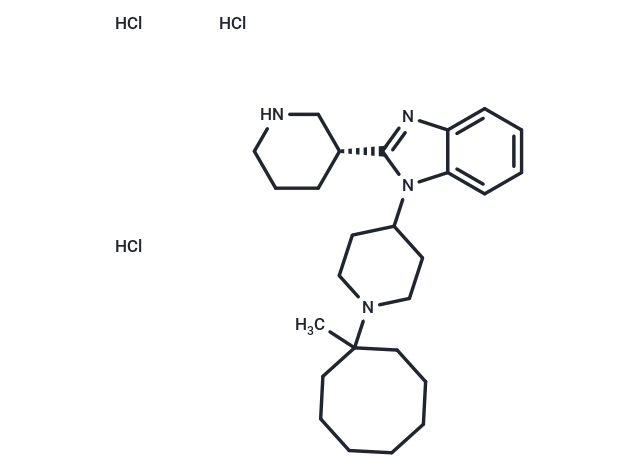Shopping Cart
- Remove All
 Your shopping cart is currently empty
Your shopping cart is currently empty

MCOPPB triHydrochloride (MCOPPB 3HCl) is a nociceptin receptor agonist.

| Pack Size | Price | Availability | Quantity |
|---|---|---|---|
| 2 mg | $29 | In Stock | |
| 5 mg | $46 | In Stock | |
| 10 mg | $79 | In Stock | |
| 25 mg | $166 | In Stock | |
| 50 mg | $268 | In Stock | |
| 100 mg | $395 | In Stock | |
| 200 mg | $563 | In Stock | |
| 1 mL x 10 mM (in DMSO) | $53 | In Stock |
| Description | MCOPPB triHydrochloride (MCOPPB 3HCl) is a nociceptin receptor agonist. |
| Targets&IC50 | Nociceptin receptor:10.07 (pKi) |
| In vivo | Only Parthenolide, the HDAC inhibitor with anti-inflammatory features, displayed a potent anti-apoptotic effect in Phb1 KO hepatocytes. Indeed, TSA and Parthenolide-treated hepatocytes showed increased levels of FXR, and reduced levels of CYP7A1, HDAC4, TNFα, TRAIL and Bax suggesting a less toxic effect of bile acids as a results of specific HDAC inhibition, resulting in the attenuation of the Phb1 KO hepatocytes apoptotic response. Importantly, Parthenolide exerts a protective effect from the liver injury after BDL in Phb1 KO mice. Indeed, Parthenolide treatment results in a reduction of the mortality rate of this mice after BDL associated with a lower apoptotic response as revealed by a reduction of necrotic areas, Tunel-staining, as well as decreased ALT (8431±957 vs.4225±210 U/L) and AST (4805±300 vs.2242±438 U/L) activities compared to control Phb1 KO mice[3]. |
| Kinase Assay | Binding assay: Kinases are produced displayed on T7 phage or by expression in HEK-293 cells and tagged with DNA. Binding reactions are performed at room temperature for 1 hour, and the fraction of kinase not bound to test compound is determined by capture with an immobilized affinity ligand and quantitation by quantitative PCR. Each kinase is tested individually against CEP-32496. Kd values are determined using eleven serial 3-fold dilutions and presented as mean values from experiments performed in duplicate. Variability between individual values is less than 2-fold. |
| Alias | MCOPPB trihydrochlride, MCOPPB 3HCl |
| Molecular Weight | 518.01 |
| Formula | C26H43Cl3N4 |
| Cas No. | 1108147-88-1 |
| Smiles | Cl.Cl.Cl.CC1(CCCCCCC1)N1CCC(CC1)n1c(nc2ccccc12)[C@@H]1CCCNC1 |
| Relative Density. | no data available |
| Storage | Powder: -20°C for 3 years | In solvent: -80°C for 1 year | Shipping with blue ice. | |||||||||||||||||||||||||||||||||||
| Solubility Information | DMSO: 32.04 mg/mL (60 mM) H2O: 16.02 mg/mL (30 mM) | |||||||||||||||||||||||||||||||||||
Solution Preparation Table | ||||||||||||||||||||||||||||||||||||
H2O/DMSO
DMSO
| ||||||||||||||||||||||||||||||||||||

Copyright © 2015-2024 TargetMol Chemicals Inc. All Rights Reserved.